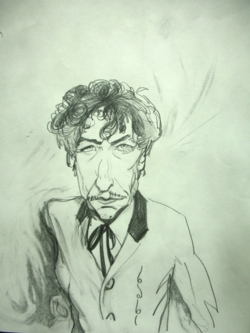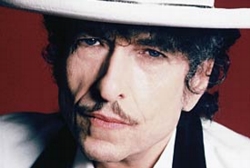 June 07
June 07
He’s Not There (2007): Talkin’ Bob Dylan Symposium Blues
by Stephen Hazan Arnoff
p. 2 of 2
 Families and parents of all shapes and sizes do get grilled in Dylan's rereading of the story of the Binding of Isaac, but at the same time, on a grander mythic level, it is one of the best examples of Dylan’s hunger to reveal the dark side of the nexus of altars and human-divine talk. If the story of Cain is a biblical prototype for murder in the throes of both ritual and familial passion at an altar, the story of Abraham and Isaac comes in a close second.
Families and parents of all shapes and sizes do get grilled in Dylan's rereading of the story of the Binding of Isaac, but at the same time, on a grander mythic level, it is one of the best examples of Dylan’s hunger to reveal the dark side of the nexus of altars and human-divine talk. If the story of Cain is a biblical prototype for murder in the throes of both ritual and familial passion at an altar, the story of Abraham and Isaac comes in a close second.
Highway 61 runs right down the center of the United States, beginning in Minnesota at the Canadian border near Dylan’s birthplace and ending in New Orleans at the Gulf of Mexico. Also known as the Blues Highway, Highway 61 was a primary route of Exodus of slaves from the South towards the industrial cities of the North. As Dylan hears it:
Oh God said to Abraham, 'Kill me a son'
Abe says, 'Man, you must be puttin' me on'
God say, 'No.' Abe say, 'What?''
God say, 'You can do what you want Abe, but
The next time you see me comin' you better run'
Well Abe says, 'Where do you want this killin' done?'
God says, ‘Out on Highway 61.’
According to his midrash – the ancient Jewish art of interpreting biblical texts that Dylan falls into by purpose, instinct, or chance – Abraham is an easily corruptible huckster who builds an altar for his own son, a model venue for the four successive verses of the blind leading the lame that follow. Highway 61 is the site of a flippant conversation between God and Abraham – the name of Dylan’s father, as the second cousin by marriage at shul might have added – that produces not only bad talk leading to a bad altar, but an endless cycle of a suffering that orbits around it.
A Fun Loving Guy
Yet even this multilayered reading of the perils of family and a wicked mythic pattern could not stand alone in the face of reports from the field by Bobby Vee, who lit another lamp on the highway in the auditorium after official greetings and the music of Spider John and Tony Glover.
Tan and slim with grey hair slicked back, five decades in the music business and recipient of thirty-eight top ten hits and seven gold records, Vee moved lightly in a double-breasted jacket and jeans to the tip of the proscenium. He radiated an I’m-so-happy-to-be-here smile, palms open, relaxed in his element, working the room. As his lapel mic kept flickering in and out forcing him to share a hand-held with the interviewer, Vee remembered without pretension how he and his band had given a kid named Elston Gunnn a shirt for their first show together because he hadn’t had a clean one to wear; how Gunnn with three “n’s” had been working as a busboy in a dive, but still claimed to have just come off of a tour with Conway Twitty. Zimmerman cum Gunnn cum Dylan banged on the piano with Vee’s band for a month until just before Buddy Holly’s plane went down in an Iowa field and he had passed the reigns of rock and roll on to both of them: Vee would replace Holly on the tour that had also taken the lives of Ritchie Valens and the Big Bopper. Dylan would claim at the 1997 Grammy Awards to have locked eyes with Holly from the audience at the Duluth National Guard Armory just before his death in an exchange of spirit that had animated Dylan’s work, especially the recording of the breakthrough album of the most recent portion of his career, Time Out of Mind. “He was a good-spirited guy, a fun loving guy,” Vee said of Dylan. “And he stays as current as the bread in the bakery.”
 Here was straight talk amidst the interpretive rambling: Bobby Vee, one of Achilles’ own soldiers, stepping out of a flat narrative tapestry and describing the hero tying his sandal, an ordinary, ratty guy like you and me through whom an unexplained gust of genius had blown, shifting sense in the world. Information about the singer within the songs served each listener’s need to bring him down to earth somehow, to construct a biography with reasons and causes explaining how this person could or could not contain his gifts.
Here was straight talk amidst the interpretive rambling: Bobby Vee, one of Achilles’ own soldiers, stepping out of a flat narrative tapestry and describing the hero tying his sandal, an ordinary, ratty guy like you and me through whom an unexplained gust of genius had blown, shifting sense in the world. Information about the singer within the songs served each listener’s need to bring him down to earth somehow, to construct a biography with reasons and causes explaining how this person could or could not contain his gifts.
Even more, as sane, sensitive, and invested as interpretative obsession with the work of a great artist may be, it is also interminably personal. Stories of encounters with Dylan played counter to the universe of the artist’s sounds, images, words, or movements inevitably blending with the interpreters’ own hopes and dreams, creating an echo chamber of meaning where hearing or remembering who spoke first – the artist or the listener – was difficult. Questions rose and fell as to whether Dylan and his listeners could actually be talking about the same thing at all.
10,000 Talkers
I recently returned to my copy of Scorsese’s No Direction Home, looking for the scene of former singing partner and lover Joan Baez explaining how if you don’t “get” Bob Dylan his music can fall totally flat, but if you do, he can touch you so deeply that it is painful to hold. I found an excerpt of Mavis Staples instead, scion of one of the great gospel vocal groups ever, mistress of a thick, trembling, soulful voice that can crack open mountains, and, rumor has it, one of 60’s hipster Dylan’s unrequited loves. She sings a few verses of “A Hard Rain’s A-Gonna Fall” in the film, coming to the line “I saw 10,000 talkers whose tongues were all broken,” pausing, saying “Lord have mercy,” and then a few lines later, she stops and sucks in a long breath before the camera cuts away, tears welling-up in her eyes.
Rightly so, after all of this talk of talking, it is difficult to bring forth a sense of what all of this Dylan Talk brought to the world – more broken tongues and windbags to make poets cry? Maybe it was only the reflection of a sense of a shared purpose for seeking meaning in the brave, beautiful, up and down experience of elevating language through listening and talking in a world so full of flat, mundane, damaged words – but I still sensed many small prayers in the air.
The core story of Dylan’s most compelling recent work is his wandering characters’ experience of exile on the flat, haunted earth – from paradise due to some unnamed crime, from a lover, or from a sense of where they could otherwise be. The wanderer wrestles with the tensions of choosing to report his experience of the world. Should he talk or plead his way out of it or simply resign himself to a path of silence, reflection, and survival? These choices carry Dylan’s work into conflicts that have shaped the most cutting, definitive, and radical religious art of recent times.
As in Franz Kafka's “Before the Law” – where a man from the country wastes his entire adult life waiting to enter the gate containing the Law only to discover on the verge of death him that the door had been meant only for him all along if only he had opened it – Dylan’s characters are primary witnesses to humanities’ losing its ability to communicate with and influence the divine. Even though it is only one answer to exile, in “Senor (Tales of Yankee Power)" (1978) Dylan offers a stunningly close parallel to the set-up of Before the Law. Yet his hero, standing alongside the messianic figure of Senor, reaches a very different conclusion than that of Kafka’s man of the country with a lost and frozen soul:
Senor, senor, do you know where we're headin'?
Lincoln County Road or Armageddon?
Seems like I been down this way before.
Is there any truth in that, senor?
How long are we gonna be ridin'?
How long must I keep my eyes glued to the door?
Will there be any comfort there, senor?....Senor, senor, let's disconnect these cables,
Overturn these tables.
This place don't make sense to me no more.
Can you tell me what we're waiting for, senor?
As on Highway 61, a vacuum of corruption has filled the crossroads where the Law may have once obligated the world to make some kind of sense. Dylan’s hero turns to Senor, the Spanish term for the Lord, and demands action. Despite recent, perhaps cunning claims to the contrary, Dylan’s characters keep walking, talking, paying, praying, loving, longing, packing, moving, and chalking it all up to a written, recorded, performed experience of words of challenge and comfort – a full-on package of options for making meaning out of exile even when they fade in fatigue to silence.
Rabbi Moshe Chaim Efraim of Sadilkov – grandson of the Baal Shem Tov, the founder of Hasidism – put it this way in a teaching translated by Arthur Green and Barry Holtz in Your Word is Fire. Prayer, listening, silence, and words all share mysteries to keep:
Take special care of what you do in the moments immediately after prayer.
The spirit of your worship may remain with you
and affect your thoughts and deeds.
One who prayed with great fear of heaven may see awe turn to anger.
One whose prayer was an outpouring of love
may be overwhelmed by unwanted passion.
In order to avoid such pitfalls,
it is best after prayer to begin at once your work and study.These words require careful thought,
but their implications are best not committed to writing.
These are choices worth talking about – Dylan’s and more; almost imperceptible altars for crafting something beautiful or useful or dissonant or inspiring out of these blues.
Stephen Hazan Arnoff’s essay on Philip Roth was recently awarded the Rockower Jewish Press Award in the category of Jewish Arts & Criticism. He presented his article on Bob Dylan’s Modern Times at Highway 61 Revisited: Dylan’s Road from Minnesota to the World at the University of Minnesota in March 2007. The article was chosen in Italy as one of twelve definitive critical articles ever written on Bob Dylan and will be published by Interlinea Press in 2008. He is the Managing Editor of Zeek.








